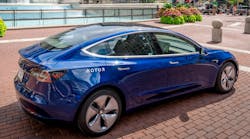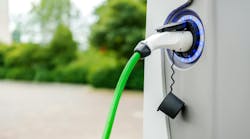By facilitating and accelerating the adoption of electric vehicles, utilities can manage their inevitable load growth better, increase revenue, connect customers with cleaner, more cost-effective transportation solutions, and support local, state and national climate goals. Simply put, utilities are best positioned to ensure uniform adoption is available equitably across varied geographies and socioeconomic levels.
The transition from fossil fuels is forging ahead, and it is not just environmental leaders propelling the movement. The federal government aims to achieve a carbon-free energy sector by 2035 and a net-zero emissions economy by 2050. To meet these and other climate goals, government and industry must work together to address the major contributors of emissions swiftly.
The transportation sector is the largest contributor of U.S. greenhouse gas emissions, according to the U.S. Environmental Protection Agency — the overwhelming majority of which comes from light-duty vehicles, like passenger cars. In 2021, President Biden set a goal to make 50% of all new vehicles sold emit zero emissions by 2030. Numerous legacy automakers are even on board, and rightfully so. It has simply never been more important for Americans to make the switch to electric vehicles (EVs).
All the while, the electric utility industry is on the precipice of change. Utilities will play a critical role in driving the shift to EVs, and there is strong public interest for them to do just that. According to a June 2022 Edison Electric Institute report, the number of EVs on the road is projected to reach 26.4 million, or 10% of all light-duty vehicles, in 2030. While that represents a rapid, significant increase from the current figure of around 5%, it simply is not enough to meet U.S. goals.
Accelerating Adoption
Seeing the vast potential for electricity-based transportation to curb carbon emissions, a team within The AES Corporation incubated Motor, a company that works with utilities to accelerate EV adoption through its unique program for residential customers. Once implemented, customers can sign up through a fully digital process to have an EV delivered to their house — initially on a month-to-month subscription — with EV onboarding, home-charging installation and enrollment in the
utility’s managed charging programs.
AES Indiana
AES Indiana has partnered with Motor since 2020 to get consumers into EVs faster and expedite the clean-energy transition. The partnership is a blueprint for the positive impact utilities can have on EV adoption while ensuring that the grid remains resilient and energy prices are affordable into the future. During the first year of its partnership with AES Indiana, Motor accounted for 20% of new EV adoption in Indianapolis, with an average load growth increase of 35% per member. Additionally, more than 75% of qualifying customers are enrolled in AES Indiana’s new managed charging program.
Utilities clearly have an incentive to encourage customers to switch to EVs. They offer a tremendous growth opportunity to both expand utilities’ customer base and increase the energy usage of existing customers in a planned, managed way. Managed charging programs enable better load forecasting to mitigate the potential for overloaded grids, which in turn benefits all utility customers. Accelerating EV adoption also spreads utilities’ fixed costs over a broader customer base, enabling utilities to keep rates affordable while investing in cleaner energy.
An EV Partnership
Having a partner with an integrated adoption platform to guide customers through the EV journey has been a huge asset for AES Indiana and makes it easy to bring managed charging enrollment to the point in the customer journey when it is most relevant to customers — when they first get an EV.
The federal government also is encouraging utilities to convert to more sustainable energy sources — and even incentivizing it. The passage of the Inflation Reduction Act brings US$370 billion in subsidies for EVs and other clean-energy developments through extended and expanded tax breaks and other means.
Moreover, geopolitical instability and pipeline infrastructure challenges are driving painful fuel price increases for consumers. Switching from a gas-powered vehicle to an EV saves money on fuel costs and long-term vehicle maintenance costs while also reducing environmental impact.
Consumers are aware of this and are increasingly curious about EVs. A national Consumer Reports survey in 2022 found 71% of respondents had some level of interest in buying or leasing an EV. Yet only 9% said they were very familiar with the fundamentals of owning an EV. Those who are interested in EVs frequently find the process of acquiring a vehicle, obtaining insurance and figuring out maintenance overwhelming. Utilities are well positioned to demystify and simplify this process. Since Motor’s turnkey EV services became available to AES Indiana customers, those who enrolled have reported high levels of satisfaction with their EV experience.
The availability of public charging stations also is spotty and inequitably distributed at best, something EV dealers regularly cite as an obstacle to sales. Access to at-home charging with installation through Motor is a major selling point for AES Indiana’s customers.
Utility customers are not the only ones who benefit from EVs. In Indianapolis, residents rely heavily on their personal vehicles to get around, fueling greenhouse gas emissions. Every resident in the city benefits from improved air quality by reducing auto tailpipe emissions.
States also benefit from utilities boosting EV adoption. Electrification plans and policies are in place in numerous states already. Almost every state in the U.S. now incentivizes zero-emission vehicle sales or adoption. More than a dozen states require auto manufacturers to sell a certain number of zero-emission vehicles annually. California has set 2035 as its target date for ending the sale of new gas-powered light-duty vehicles altogether, and several more states are likely to follow. Utilities are advancing these efforts by offering their own EV incentives, such as rebates, grants and off-peak charging price reductions.
Electric Ambitions
The future of energy is electric, and it is already upon us. Utilities must be ready to meet the moment and collaborate with governments, technology leaders and other stakeholders working toward climate and energy goals. The more EVs on the road, the faster these ambitions can be achieved.
Millions of Americans want EVs, but too few end up getting them. It must be as easy and convenient to acquire and use EVs as traditional fuel vehicles. Utilities like AES Indiana are essential to closing the gap between consumer appetite and adoption. And in doing so, they support their own business growth, enable a sustainable grid and help to make cities, states and the nation a healthier place to live.
Praveen Kathpal ([email protected]) is CEO of Motor, a fast-growing company that helps electric utility companies accelerate consumer EV adoption. He previously served as VP of New Business at AES Next and as VP of Market Applications at Fluence, a leading energy storage technology and services company. He has served as chair of the Energy Storage Association board of directors. Prior to joining AES, Praveen was a consultant at ICF International. He holds a BA in Economics and an MBA from the University of Virginia. Praveen is actively engaged in his community, serving on the City of Alexandria’s Climate Task Force, and previously as chair of its Environmental Policy Commission.
Brandi Davis-Handy serves as chief customer officer for AES’ utilities in Indiana and Ohio. Within this role, she leads a team focused on providing an exceptional customer experience and accelerating efforts on new solutions to help customers achieve their most important objectives of reliability, affordability and sustainability. Prior to AES, she served as Chief Marketing and Communications Officer at Project Lead The Way and has also led communications teams at OneAmerica Financial Partners and the American Cancer Society.




